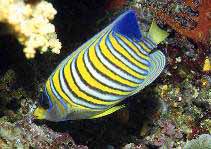- Royal angelfish
Taxobox
name = Royal angelfish

image_caption = Royal angelfish on the coast ofGuam
regnum =Animal ia
phylum = Chordata
classis =Actinopterygii
ordo =Perciformes
familia =Pomacanthidae
genus = "Pygoplites"
species = "P. diacanthus"
binomial = "Pygoplites diacanthus"
binomial_authority = (Boddaert, 1772)The royal angelfish, "Pygoplites diacanthus", is a species of
marine angelfish of the familyPomacanthidae , the only member of the genus "Pygoplites". It is found intropical Indo-Pacific oceans fromRed Sea andEast Africa to the Tuamoto Islands, north toRyukyu andOgasawara islands, south to theGreat Barrier Reef andNew Caledonia , at depths down to 48 m. Its length is up to 25 cm.The royal angelfish occurs in
coral -rich areas of lagoon and seaward reefs, often found in the vicinity of caves. It feeds on sponges andtunicate s. It is solitary or in pairs, or in groups.Coloration of the royal angelfish is sides with alternating dark-edged bluish white and orange stripes which narrow and angle backward in dorsal fin, the posterior portion of the
dorsal fin black with close-set blue dots, the posterior portion ofanal fin with alternating yellow and blue bands running parallel to body contour, and thecaudal fin yellow. Juveniles have a large ocellated dark spot on the basal portion of the soft dorsal fin.In the aquarium
Although it is frequently exported through the aquarium trade it rarely survives in the aquarium.
Usually specimens abused during shipment, more likely caught by drugging, will refuse to eat anything, including live fare.However, given the right environment, specifically with smaller and docile tankmates like gobies and dwarf angels, it will start feeding within days when fed brine shrimp, brine shrimp plus flakes, and further progressing to regular frozen foods and a certain brand of cichlid pellets which this species seem to crave.
With a hostile environment with fellow large angels, puffers, and triggers, and certain clowns, it will almost certainly fail to acclimate and slowly die of starvation due to its shyness to start feeding.
Survivability of feeding specimens seem to equal to the other Pomacanthids.
Fresh water dips may be required to rid newly arrived specimens of flukes and ick which this species is especially prone to.
The prior myth that only yellow-bellied variations from Sri Lanka and the Red Sea will survive points to the fact that species from the Philippines and Indonesia are often abused when collected.
References
*
Wikimedia Foundation. 2010.
